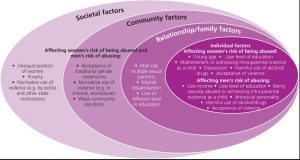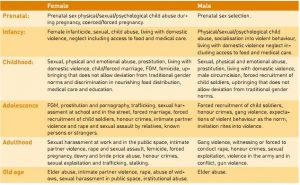
Introduction:
- World Health Organization defines violence as “the intentional use of physical force or power, threatened or actual, against oneself, another person, or against a group or community, which either results in or has a high likelihood of resulting in injury, death, psychological harm, mal-development, or deprivation.”
- When we talk about violence, we usually think of violence against woman. But in real situation some men also experience violence. The term gender based violence covers violence against both man and woman.
- “Gender-based violence (GBV) is the general term used to capture violence that occurs as a result of the normative role expectations associated with each gender, along with the unequal power relationships between the two genders, within the context of a specific society.” (Bloom 2008, p14).
- World Health Organization (WHO), 2013 indicates, one in each three woman has been beaten, forced into sex or mishandled in some other way – regularly by somebody she knows. It is found that one out of five women is sexually mishandled as per a 2014 report.
- As disparity between male and female still exists in the world; powers are unequally distributes among sexes in the society. Woman are the main focus of sex based savagery i.e. GDV and frequently needs to endure the aggravated outcomes when contrasted with what men have to experience.
- Females generally have weaker social and financial status than men and also less accessibility to family assets and forced to become victim of gender based violence.
Forms of Gender Based Violence (GBV):
1. Domestic violence: Violence experienced by individual in household settings between the intimate partners or between the household members. E.g. beating children, wife, abuse etc
2. Sexual abuse: Sexual violence is characterized as confrontation of a person in sexual demonstration/ act without that persons consent. E.g. Rape, endeavoured assault, sexually mishandling, sexual misuse, sexual exploitation etc
3. Physical violence: It is the type of violence in which physical force is used by a person against another person that causes harm, injury or even death. E.g. Kicking, Beating, Slapping etc
4. Psychological/ Emotional abuse: Psychosocial abuse is a type of violence that results in psychological/mental suffering to a person such as depression, anxiety, suicidal tendencies, humiliation etc. E.g. isolating someone, threatening, stalking, name calling etc.
5. Economic violence: It is a form of violence in which a person has compliance over another person’s access to financial assets. E.g. taking/snatching money from you, lack of access to finance, refusal from working etc
6. Harmful traditional practices: Harmful traditional practice is a type of violence conducted and accepted as part of culture primarily against woman/ girls in some societies causing suffering to them. E.g. Early marriage, dowry system, son preference, crime committed in the name of honour.
Factors influencing Gender based violence:

There are various factors that may increase the risk of suffering from gender based violence. Following are the different level factors for gender based violence:
- Individual factors
- These are the personal level factors that increase the vulnerability for gender based violence.
- Young aged person: is more vulnerable to violence as he/she has less understanding towards violence and also physically less powerful.
- Gender: Mostly female are more susceptible to violence than men
- Education: Educated person have better understanding about violence and can take appropriate steps in overcoming or fighting against violence. Uneducated are not able to make proper self decision as compared to educated person.
- Childhood physical abuse/ witnessing violence: Child who suffered from violence in their childhood or who has been witnessing violence in the family/ society are likely to be the perpetrator for violence as the child may develop thinking it is the right thing to do.
- Alcohol and Substance use: A person in the influence of alcohol, drugs are not in the right state of mind and may cause violence to other person or to family members.
- Lack of knowledge/information: When person have no idea what to do if they suffer from violence or don’t know the law, then probably that person is more likely to be the victim of violence.
- Mental health: People with severe mental disorder such bipolar disorder are likely to cause harm and injury to others.
- Family factors
- Man has multiple sexual partners: If a man has multiple sexual partners; man may beat his wife and also they may be fights between wife and the other partner of the man.
- Marital dissatisfaction: When there is no satisfaction in marriage, often fight initiates and take the shape of violence like beating, torture, throwing stuffs etc.
- Community factors
- Cultural belief and practices: Traditions of dowry, early marriage are likely to make woman prone to violence.
- Weak law: Weaker implementation of law makes perpetrator’s intention more strong in carrying out violence.
- Societal factors
- Poverty: People who are poor and have less access to resource are more likely to suffer from violence.
- Gender inequalities: Male are thought to be superior than female, when it comes to right then, rights of woman are suppressed and become more susceptible to violence as compared to men.
Outcomes of Gender based violence:
a) Effect on physical health
- Violence can cause injury, disability, death to the victim.
- It may result in broken bones.
- Chronic pain, respiratory problems, gastrointestinal problems etc.
- Risk of pregnancy.
- Victim may suffer from Sexually transmitted diseases (STDs) such as HIV/AIDs, gonorrhoea.
- Pelvic inflammatory disease
- Unwanted pregnancies and complication may arise.
b) Psychological outcomes
- Depression, Anxiety, constant fear
- Post traumatic stress disorder
- Suicidal tendencies, panic attack
- Withdrawal symptoms may be seen
- With extreme stress, victim is likely to use alcohol, tobacco, drugs etc.
c) Effect on social health
- Victims may have to face social isolation, criticisms from society.
- Absenteeism from work, educational institution
- Bad attitude towards victim by society members.
- Affects social and human right of victim.
- Increased vulnerability to future violence
d) Effect on victim’s family
- Family may not accept the victim.
- Domestic violence may increase.
- Lack of care to children may result in malnutrition, disease and disorder in them
- Child may learn bad behaviour from violence
- Conflict in family which may lead to broken families.
e) Effect on society
- Lack of confidence in societal laws, policies.
- Challenge to woman participation to society and decreased productivity of woman.
- Diminished trust on social relationship.
f) Impact on perpetrator
- The perpetrator is subjected to punishment.
- Lack of acceptance from society
- Shame and blame to family on perpetrator
Lifecycle of gender based violence

Mitigation measures for Gender based violence
| Life Stages | Mitigation measures |
| Prenatal | · Making strict law against sex selective abortion.
· Making pregnant woman aware about their sexual and reproductive health rights. · Use of medias such TV, radio, internet to develop positive gender norms among couple · Carrying out training and workshops for couples. · Reducing access to alcohol especially for men |
| Infancy | · Improving legislation associated with GBV
· Political support towards gender equality · Providing financial support to family for rearing girl child if economically weak. · Raising awareness and carrying out parenting program to avoid maltreatment of child · Supporting parent to identify their violent behaviour and attitude and helping them to overcome them |
| Childhood | · Improving legislation associated with GBV
· Including gender equality and related education in the curriculum in culturally sensitive way. · Carrying out school based program to develop proper sexual orientation standards. · Identify and addressing violent behaviour and attitude of parents and helping them to overcome them |
| Adolescent | · Improving sexual and reproductive health rights
· Bringing involvement of young men in gender equality · Proper education on gender equality · Carrying out school based program to develop proper sexual orientation standards · Using social media for increasing awareness and support gender equality and avoiding violence. |
| Adulthood | · Increasing women’s participation in politics as a woman can better understand the kind of problem they face.
· Empowering woman so that they can take their own decision and make them capable to leave an abusive relationship. · Improving sexual and reproductive health rights · Fulfilling the gap between existing law and its practice. · Increasing awareness among people. · Enhancing organizational commitment; proper monitoring and supervision of staffs to reduce workplace violence. · Use of medias such as TV, radio, internet to develop positive gender norms among couple · Making and implementing public policies and intervention programs. · Promoting healthy sexual relationship |
| Old age | · Providing counselling services to family members
· Use of medias such TV, radio, internet to develop positive gender norms among couple |
References and for more information:
http://www.unfpa.org/gender-based-violence
http://www.who.int/hac/techguidance/pht/SGBV/en/
http://www.unhcr.org/3bb44cd811.pdf
http://eige.europa.eu/rdc/thesaurus/terms/1096
http://www.who.int/violence_injury_prevention/violence/gender.pdf
http://stoprelationshipabuse.org/educated/types-of-abuse/economic-abuse/
https://www.slideshare.net/rambhu21/violence-against-women-19862686
https://www.cdc.gov/violenceprevention/sexualviolence/definitions.html
http://www.w-teconline.org/types-of-gender-based-violence/
http://www.health-genderviolence.org/news/191
http://www.studylecturenotes.com/basics-of-sociology/gender-violence-definition-types-causes-with-examples
http://www.stopvaw.org/harmful_practices
http://www.gbv.scot.nhs.uk/gbv/harmful-traditional-practices
https://www.slideshare.net/Charliengo/gender-based-violence-in-malawi
http://hrlibrary.umn.edu/svaw/advocacy/modelsessions/causes_effects.PDF
https://www.yaaka.cc/unit/harmful-traditional-practices/
http://www.unwomen.org/en/what-we-do/ending-violence-against-women/prevention
https://www.pinterest.com/pin/290974825895151895/
Author of this article: Ms. Rojina Tandukar. Ms. Tandukar is pursuing her Bachelor’s degree in Public Health from a reputed University.